
Network Engineer CV examples

Build your CV on this template

Network engineers are critical to the effective running of an organisation’s computer systems and employers will take care to ensure they recruit the best.
You will need a tailored CV if you want to stand out and get interviews.
Our comprehensive guide to writing a network engineer CV will explain everything you need to know and even includes 6 sample network engineer CVs.
Article contents
Network engineer cv example.

CV templates

Cisco Network Engineer CV example
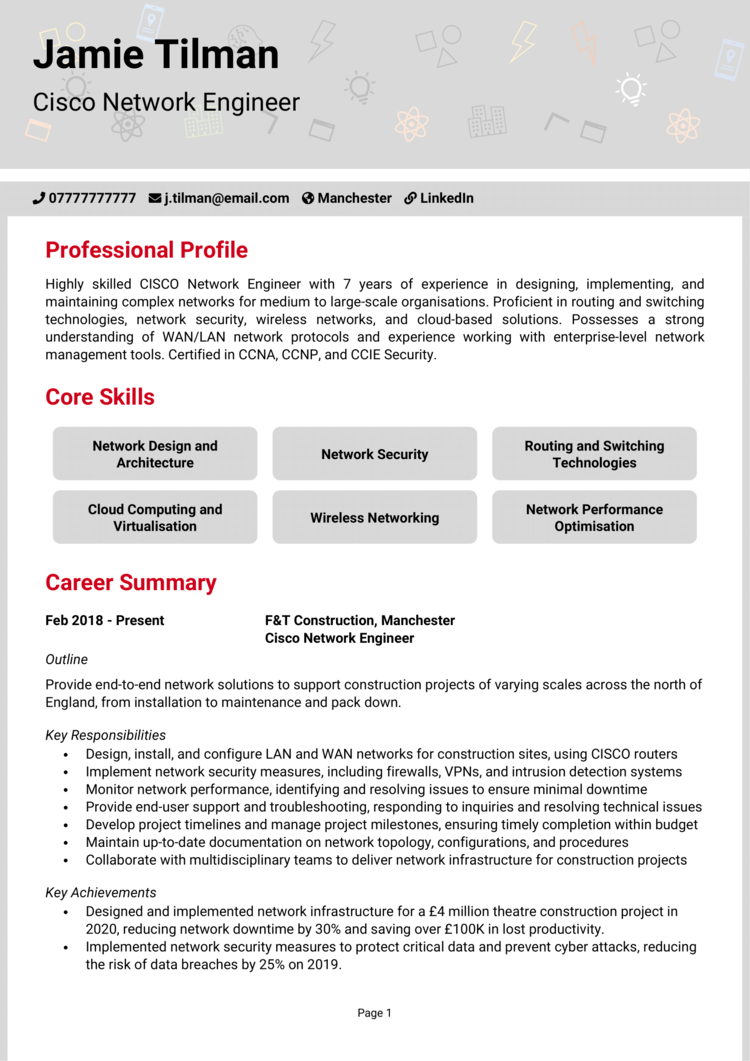
Senior Network Engineer CV example

Network Administrator

Junior Network Engineer

Network Support Engineer

The above CV example demonstrates the type of info you should be including within your Network engineer CV, as well as how to display this information in a way which looks professional and is easy for time-strapped recruiters to read.
This is the standard you should be aiming for, so remember to refer back to it throughout the CV writing process.
Network engineer CV structure and format
Recruiters are busy, and if they can’t find the information they’re looking for in a flash, it could be game over for your application.
You need to format and structure your CV in a way which allows the reader to pick out your key information with ease, even if they’re strapped for time.
It should be clear, easily legible, well-organised and scannable – check out some simple tips and tricks below:
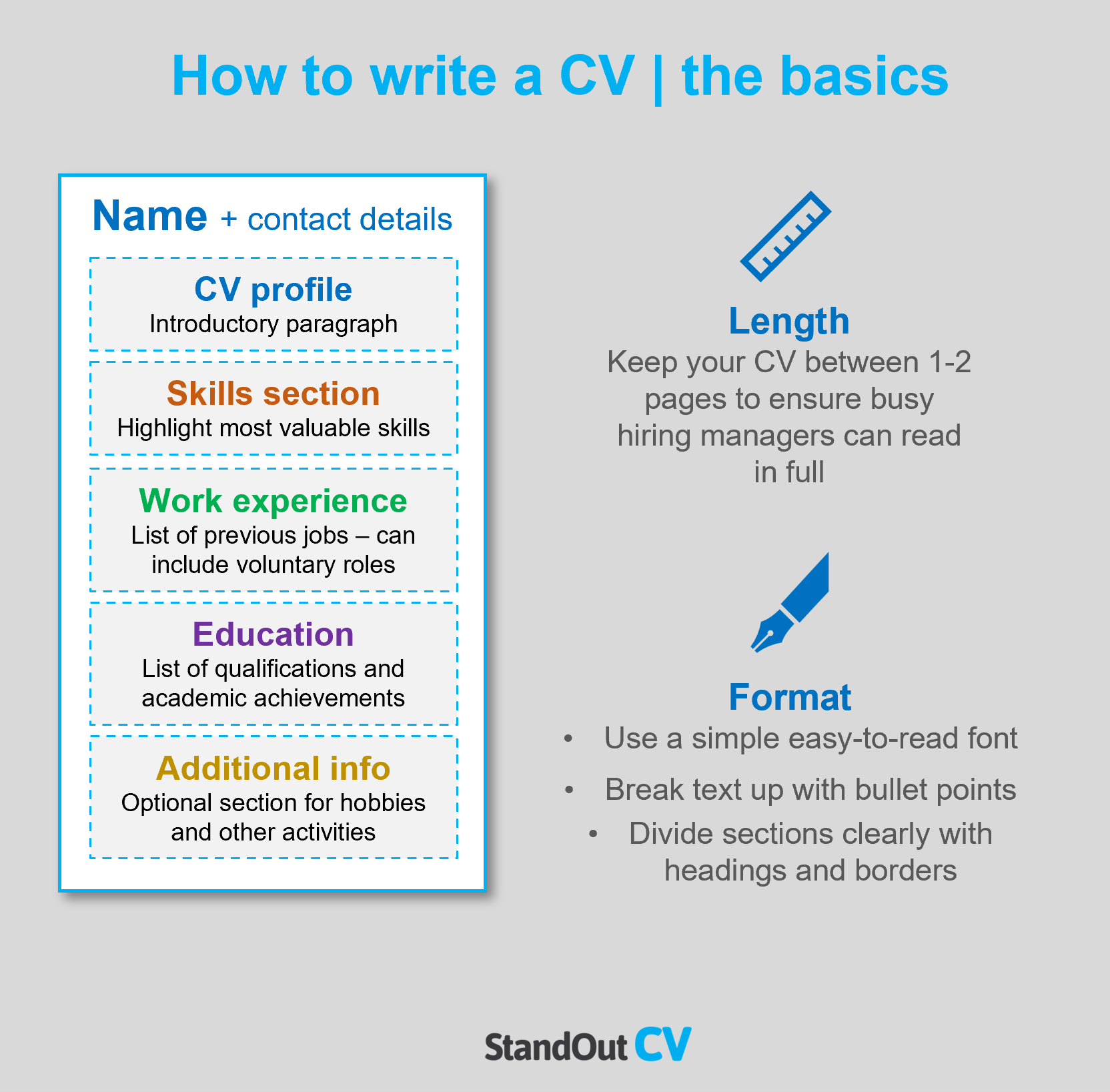
Formatting Tips
- Length: Whether you’ve got one year or three decades of experience, your CV should never be more than two sides of A4. Recruiters are busy people who’re often juggling numerous roles and tasks, so they don’t have time to read lengthy applications. If you’re a recent graduate or don’t have much industry experience, one side of A4 is fine.
- Readability : Help out time-strapped recruiters by formatting your CV for easy reading. Using lots of bullet points and lists will help them to skim through your info, while clearly formatted headings will allow them to navigate towards the content which is most useful to them.
- Design: While it’s okay to add your own spin to your CV, avoid overdoing the design. If you go for something elaborate, you might end up frustrating recruiters who, above anything, value simplicity and clarity.
- Avoid photos: Logos, profile photos or other images aren’t necessary and rarely add any value – save the space for written content, instead!
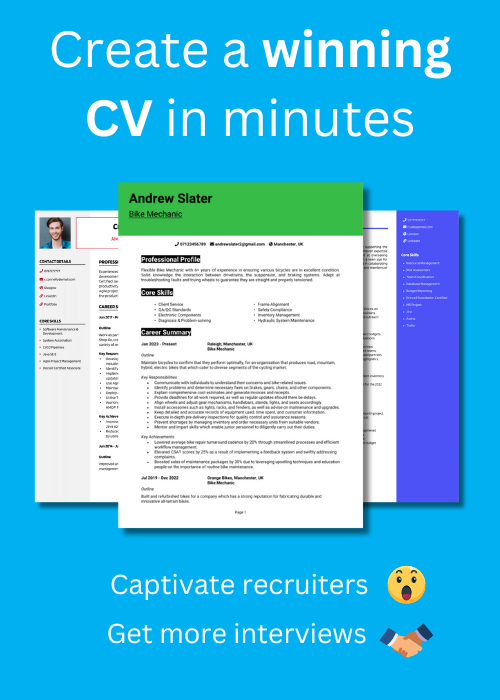
Build your CV now
Structuring your CV
For easy reading, write your CV to the following CV structure:
- Contact details – Make it easy for recruiters to get in touch with you by listing your contact details at the top of your CV.
- Profile – A short and snappy summary of your experience and skills, showcasing what makes you a good fit for the position.
- Work experience / career history – Note down all your work history, with your current position first, then working backwards.
- Education – A short list of your academic background and professional/vocational qualifications.
- Interest and hobbies – This is an optional section, which you can use to highlight any relevant hobbies or interests.
Now I’ll guide you through exactly what you should include in each CV section.
CV Contact Details
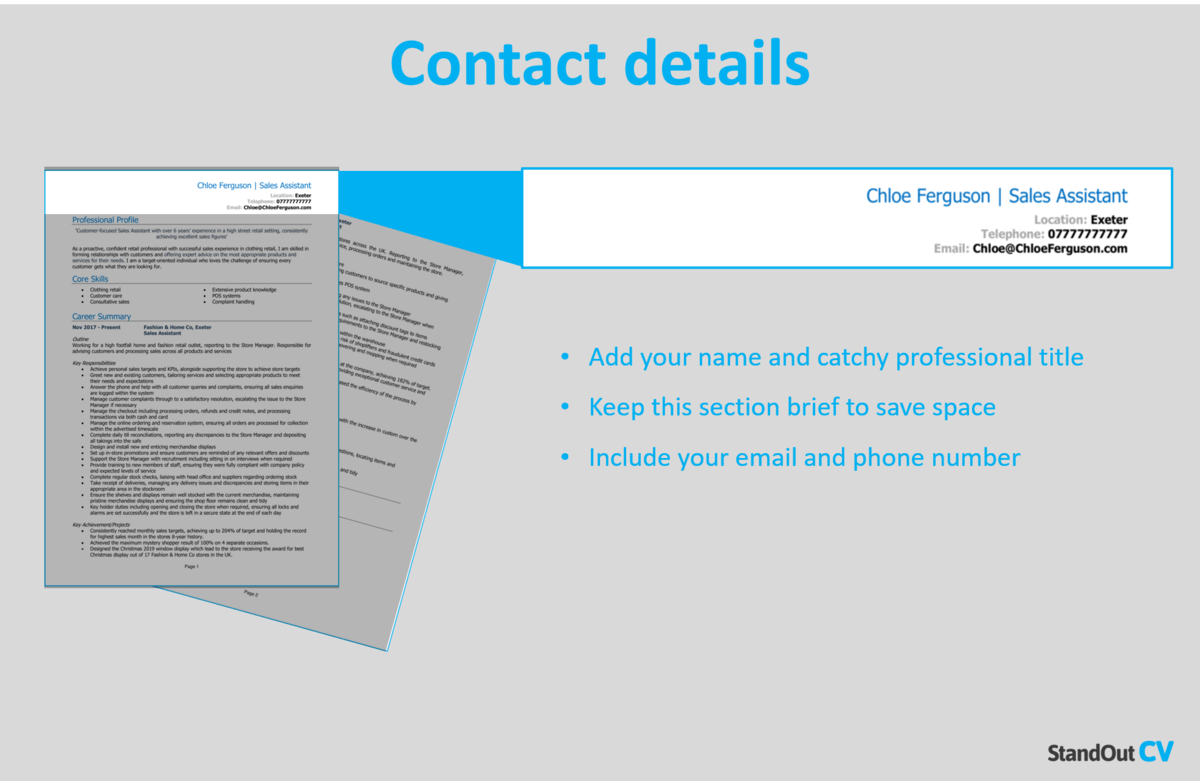
Begin by sharing your contact details, so it’s easy for employers to give you a call. Keep to the basics, such as:
- Mobile number
- Email address – It should sound professional, with no slang or nicknames. Make a new one for your job applications if necessary.
- Location – Simply share your vague location, for example ‘Manchester’, rather than a full address.
- LinkedIn profile or portfolio URL – Remember to update them before you send your application.
Network engineer CV Profile
Grab the reader’s attention by kick-starting your CV with a powerful profile (or personal statement , if you’re a junior applicant).
This is a short introduction paragraph which summarises your skills, knowledge and experience.
It should paint you as the perfect match for the job description and entice recruiters to read through the rest of your CV.
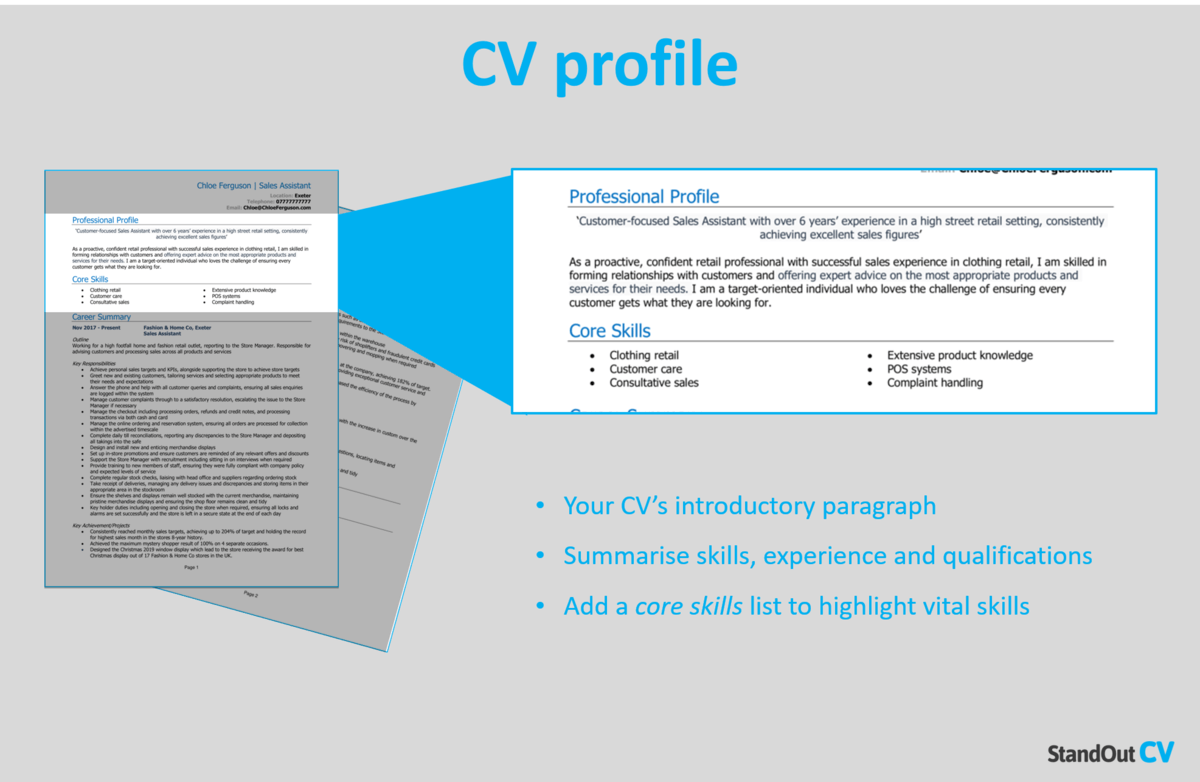
Tips for creating an impactful CV profile:
- Keep it brief: Aim for a short, snappy paragraph of 3-5 lines. This is just enough room to showcase why you’d make the perfect hire, without going into excessive detail and overwhelming busy recruiters.
- Tailor it: No matter how much time you put into your CV profile, it won’t impress if it’s irrelevant to the role you’re applying for. Before you start writing, make a list of the skills, knowledge and experience your target employer is looking for. Then, make sure to mention them in your CV profile and throughout the rest of your application.
- Don’t add an objective: Career goals and objectives are best suited to your cover letter , so don’t waste space with them in your CV profile.
- Avoid cliches: Clichés like “ blue-sky thinker with a go-getter attitude” might sound impressive to you, but they don’t actually tell the recruiter much about you. Concentrate on highlighting hard facts and skills, as recruiters are more likely to take these on board.
What to include in your Network engineer CV profile?
- Summary of experience: Recruiters will want to know what type of companies you’ve worked for, industries you have knowledge of, and the type of work you’ve carried out in the past, so give them a summary of this in your profile.
- Relevant skills: Make your most relevant Network engineer key skills clear in your profile. These should be tailored to the specific role you’re applying for — so make sure to check the job description first, and aim to match their requirements as closely as you can.
- Essential qualifications: Be sure to outline your relevant Network engineer qualifications, so that anyone reading the CV can instantly see you are qualified for the jobs you are applying to.
Quick tip: Your CV is your first impression on recruiters, so it’s vital to avoid spelling and grammar mistakes if you want to appear professional. Use our quick-and-easy CV Builder to add pre-written content that has been crafted by recruitment experts.
Core skills section
Your CV is the very first impression you’ll make on a potential employer.
A disorganised, cluttered and barely readable CV could seriously decrease your chances of landing interviews, so it’s essential to make sure yours is slick, professional and easy to navigate.
You can do this by employing a clear structure and formatting your content with some savvy formatting techniques – check them out below:
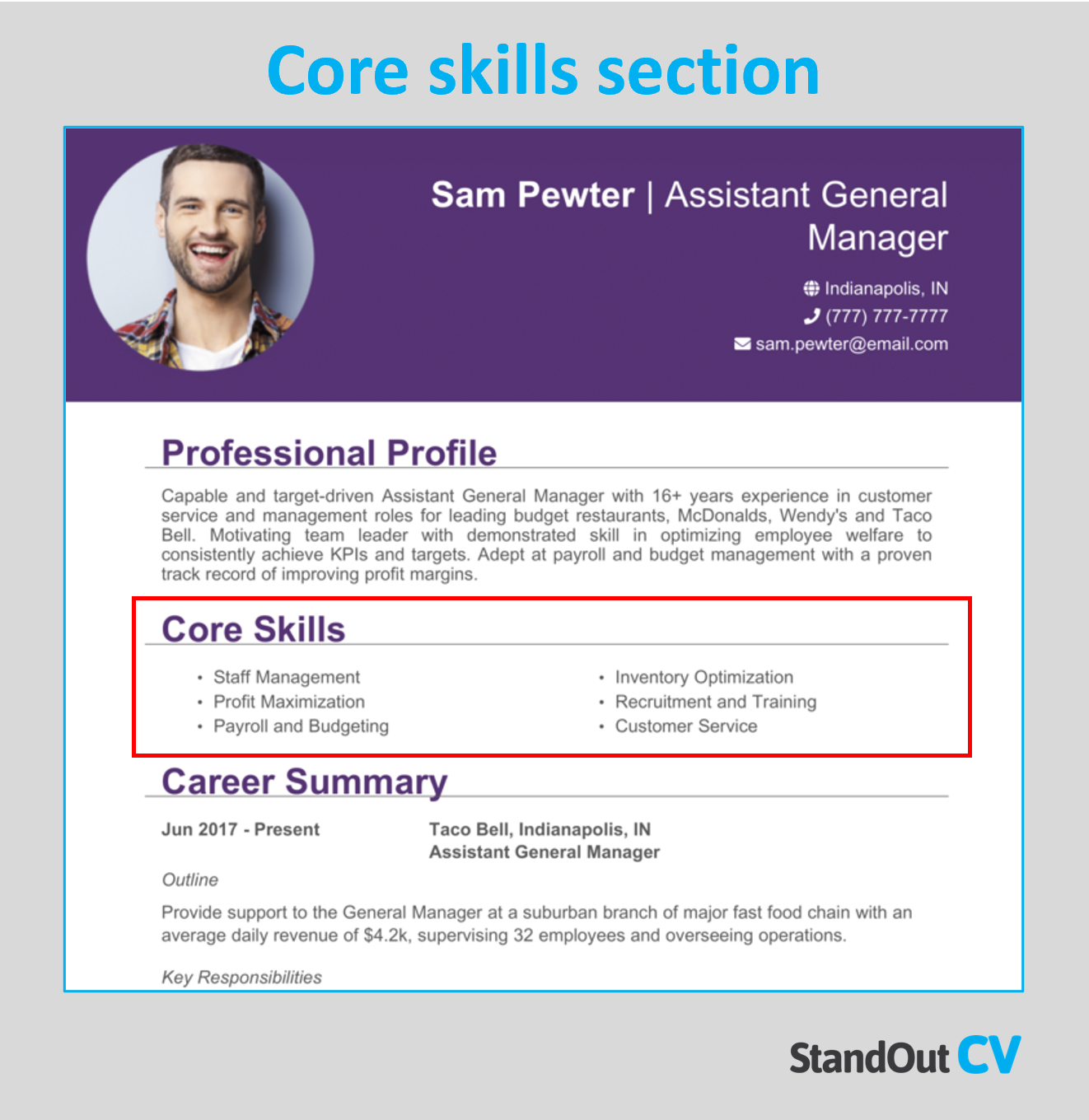
Work experience/Career history
Now that recruiters have a good overview of your skills and abilities, you need to jump into the detail of your career history.
Give them a more thorough insight into what you can do by creating a detailed list of your relevant experience.
Start with your current role, and work backwards through all the relevant positions you’ve held. This could be freelance, contract or voluntary work too; as long as it’s related to the role you’re applying for.
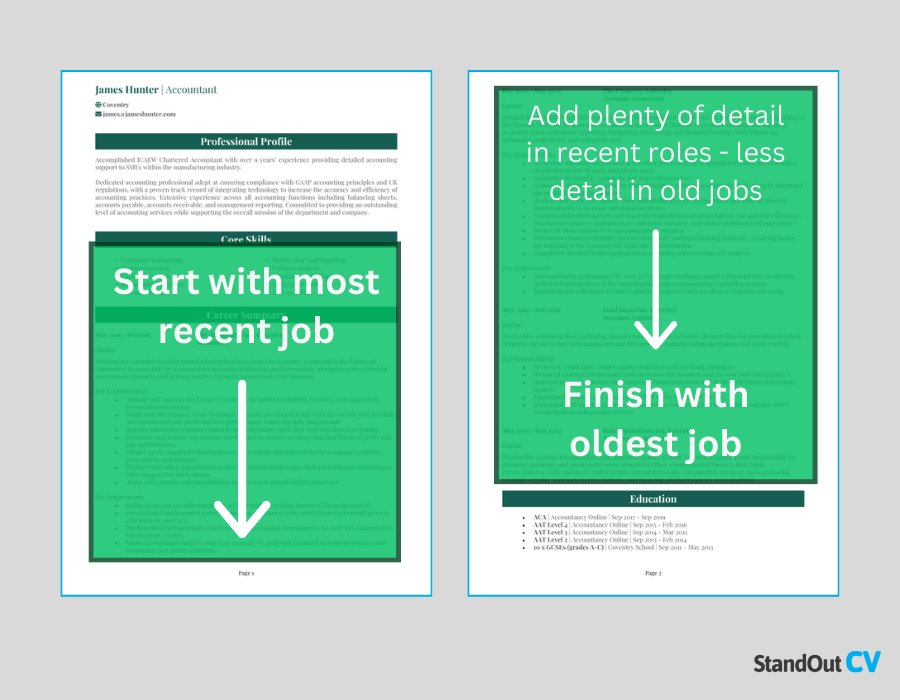
Structuring your roles
The structure of your work experience section can seriously affect its impact.
This is generally the biggest section of a CV, and with no thought to structure, it can look bulky and important information can get lost.
Use my 3-step structure below to allow for easy navigation, so employers can find what they are looking for:
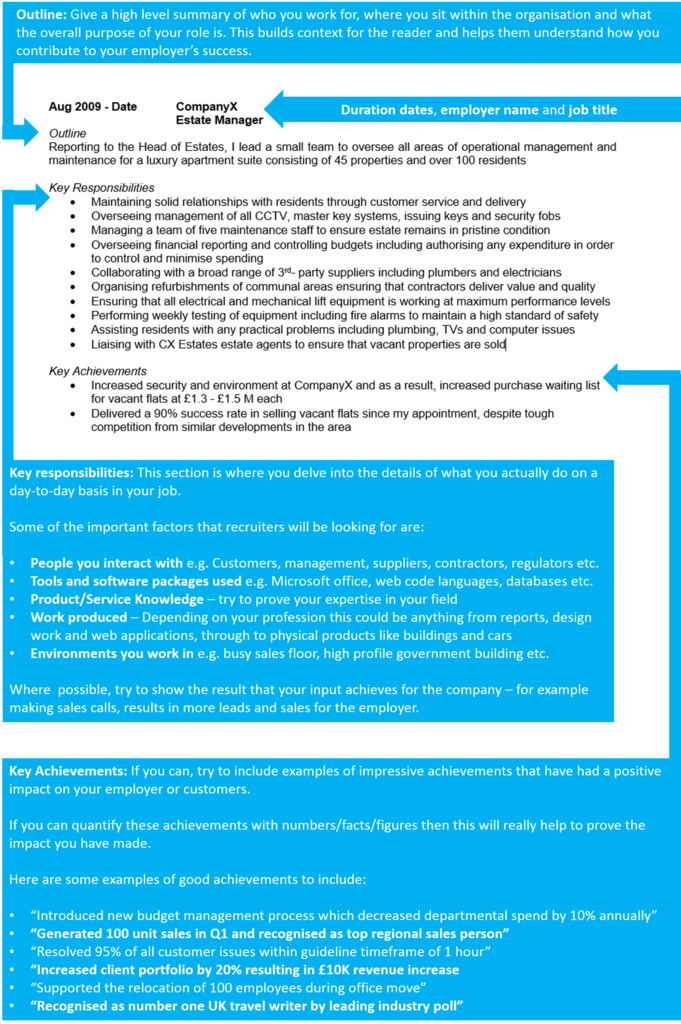
Start with a 1-2 sentence summary of your role as a whole, detailing what the goal of your position was, who you reported to or managed, and the type of organisation you worked for.
“As a Network Engineer for The Computer Agency, I ensure the high performance of network infrastructure, providing immediate support and network assistance for multiple clients across the Essex area.”
Key responsibilities
Next, write up a punchy list of your daily duties and responsibilities, using bullet points.
Wherever you can, point out how you put your hard skills and knowledge to use – especially skills which are applicable to your target role.
- Maintaining, repairing and administering computer networks for The Computer Agency clients
- Upkeeping, installing and troubleshooting computer networks, software and hardware
- Designing new networks to optimise performance and ensure security of client data
Key achievements
To finish off each role and prove the impact you made, list 1-3 stand out achievements , results or accomplishments.
This could be anything which had a positive outcome for the company you worked for, or perhaps a client/customer. Where applicable, quantify your examples with facts and figures.
- Change managing a network upgrade for a client that improved systems efficiency by 50%
- Securing 3 new local clients worth £25,000 through referrals from satisfied business owner
- Identifying poor system performance that pre-emptively shut down £2-million ransomware scam
At the bottom of your CV is your full education section. You can list your formal academic qualifications, such as:
As well as any specific Network engineer qualifications that are essential to the jobs you are applying for. Note down the name of the qualification, the organisation at which you studied, and the date of completion.
Interests and hobbies
Although this is an optional section, it can be useful if your hobbies and interests will add further depth to your CV.
Interests which are related to the sector you are applying to, or which show transferable skills like leadership or teamwork, can worth listing.
On the other hand, generic hobbies like “going out with friends” won’t add any value to your application, so are best left off your CV.
Essential skills for your Network engineer CV
Tailoring your CV to the roles you are applying for is key to success, so make sure to read through the job descriptions and tailor your skills accordingly.
However, commonly desired Network engineer skills include:
- Listening – It’s critical that you can listen attentively to understand the organisation’s needs and pain points.
- Customer service – The ability to serve users in a way that is accessible and helpful.
- Investigation – You’ll need to show on your network engineer CV that you can uncover problems, solve them quickly and analyse performance.
- Communication – You have to demonstrate that you can communicate technical matters in clear and reassuring ways to numerous different parties, as well as communicate with your own team.
- Technical – Outstanding and up-to-date technical knowledge must be listed on your CV.
Writing your Network engineer CV
When putting together your Network engineer CV, there are a few key points to remember
Always tailor your CV to the target role, even if it means creating several versions for different roles.
Additionally, remember that the structure and format of your CV needs just as much attention as the content.
Remember to triple-check for spelling and grammar errors before hitting send. If you’re unsure, use our quick-and-easy CV Builder to add pre-written expert content with one click.
Good luck with your job search!
More IT operations CV examples
- API Testing CV
- Azure Administrator CV
- CCTV Technician CV
- Chief Data Officer CV
- Cyber Security CV
- Data Architect CV
- Data Centre Engineer CV
- Data Engineer CV
- Data Scientist CV
- Database Administrator CV
- GIS Analyst CV
- Information Security Officer CV
- IT Contractor CV
- IT Director CV
- IT Manager CV
- NOC Engineer CV (Network Operation Center)
- Oracle DBA CV
- Site Reliability Engineer CV
- SOC Analyst CV
- System Analyst CV
- Technical CV

Build my resume
- Build a better resume in minutes
- Resume examples
- 2,000+ examples that work in 2024
- Resume templates
- Free templates for all levels
- Cover letters
- Cover letter generator
- It's like magic, we promise
- Cover letter examples
- Free downloads in Word & Docs
15 Network Engineer Resume Samples That Worked in 2025
Network Engineer

Best for candidates with 3+ years of experience
With your job experience and a stunning resume layout, recruiters will be ready to give your application the official stamp of approval.
Resume Builder
Like this template? Customize this resume and make it your own with the help of our Al-powered suggestions, accent colors, and modern fonts.
- Network Engineer (NetEng)
- NetEng Resumes by Experience
- NetEng Resumes by Role
- Writing Your NetEng Resume
Building a network engineer resume from scratch is a daunting task—even with the help of ChatGPT resume prompts . These nine network engineer resume templates have been optimized to help you land an interview in 2025, no matter what kind of network engineer you are or at what stage of your career.
The resumes you’ll find in this guide, and others, like our free Google docs resume templates or our interactive Word resume examples have helped network engineers get interviews at great companies like Zoom and Dropbox .
Network Engineer Resume
Used by 873 people in the last 24 hours
or download as PDF

Why this resume works
- When reviewing your network engineer resume, hiring managers have to quickly assess whether or not they think you’ll have a meaningful impact on their business. By demonstrating you’ve had a measurable effect on your past roles, you’ll make a convincing case that you deserve an interview.
- Strong use of action verbs like “drove,” “led,” and “implemented” succinctly demonstrate that you can take ownership of your roles.
- The “skills” section is comprehensive but not exhaustive. You don’t want your resume skills to be a laundry list. It’s better to demonstrate expertise in a few areas than a passive knowledge of many tools and technologies.
Senior Network Engineer Resume

- There is a clear progression of responsibilities from Dataprise through Zoom. As a senior network engineer, you want to show that you’ve taken on bigger projects as your career progressed.
- Your senior network engineer resume should show you’ve worked on a wide variety of different projects, from security to support to planning, making it clear you have the capability of contributing to several other companies.
- As a senior network engineer, your work experience section takes up most of your resume. When you have a few years of experience, hiring managers want to see what you’ve done in your previous roles above anything else. Strut your stuff with a savvy resume format that highlights your most recent experience, also known as reverse-chronological order. This is exactly how it should be.
Entry-Level Network Engineer Resume

- Unlike the “Senior network engineer” resume above, your entry-level network engineer resume needs to convey your qualifications without an extensive work history.
- As a junior network engineer, it’s appropriate to include any relevant classes you took in college that qualify you for the role. You want to lead with your strengths as you create a resume , and that might be your education when you’re an entry-level network engineer.
- Include any relevant projects you worked on outside of the school setting that demonstrate initiative and a desire to better understand what it takes to be a successful network engineer.
Junior Network Engineer Resume

- Your secret weapon here is unleashing your projects’ experiences. This means highlighting projects that you feel are related to the job, emphasizing the impact and real-world application of the outcomes.
Cloud Network Engineer Resume

- Your competency in job-specific tools will set you apart from the rest. However, desist from namedropping software to sound smart. Instead, showcase how you’ve used them to make a significant impact in your previous jobs.
Network Security Engineer Resume

- Remember to include the relevant tools and competencies that you used to keep systems protected and running optimally.
F5 Network Engineer Resume

- In fact, your F5 network engineer resume may emerge at the top of the stack for disclosing your ability to evaluate vendors and ensure sustainable cost reduction for crucial supplies.
Juniper Network Engineer Resume
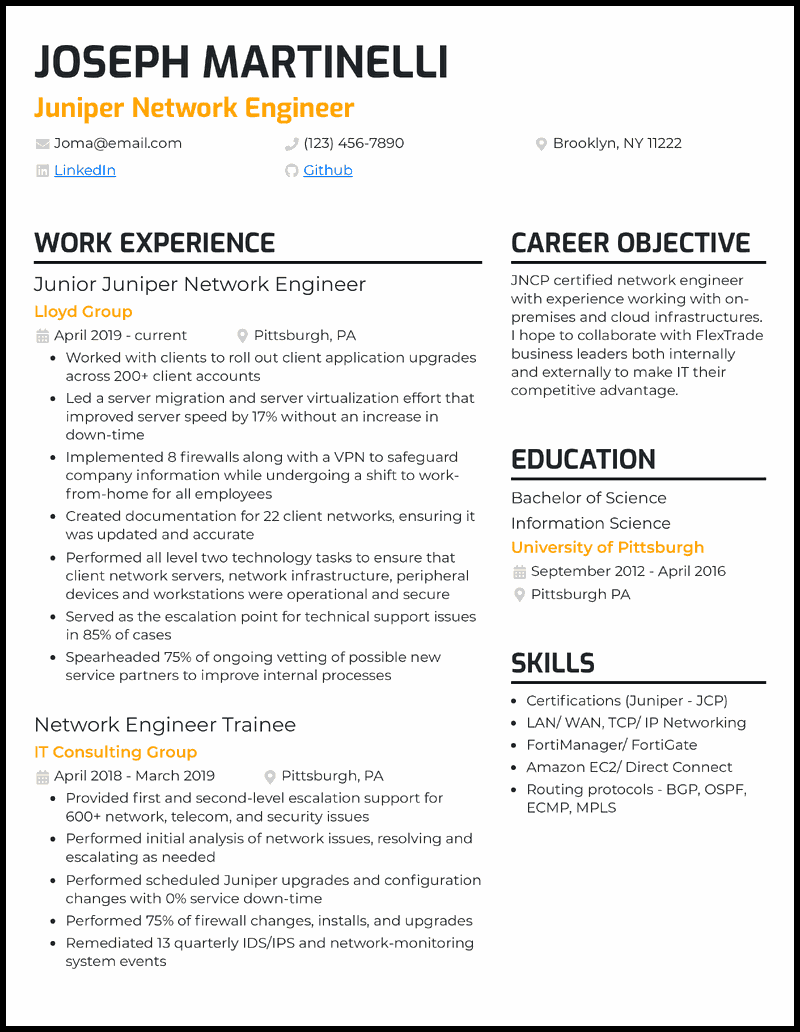
- When you’re applying for a more specialized role, you want your Juniper network engineer resume to showcase your experience in that specialization. If you’re looking for a Juniper network engineer role, you’ll stand out amongst the hundreds of other applicants by making that your focus.
- We put together over 50 resume objective examples if you’re looking for more inspiration.
CCNA Network Engineer Resume

- Frequently, certifications aren’t particularly strong signals for hiring managers. However, when you’re applying for a more specialized position, they can help you stand out from other applicants.
- As a network engineer with several years of experience, your education section should only occupy a small percentage of your overall CCNA network engineer resume .
- Try a reverse-chronological resume format for a smooth-flowing, easy-to-read story that presents your most recent positions at the top, followed by older jobs.
Cisco Network Engineer Resume

- Your bachelor’s degree in computer engineering, for instance, could be the gem that makes the education part of your Cisco network engineer resume sparkle. Make sure to mention the university you attended, its location, and timeline, too. And suppose you went the extra mile to earn a master’s degree, flip the script, and list that bad boy first, followed by your Bachelor’s.
Wireless Network Engineer Resume

- Matching your resume to the job description entails dressing it up with keywords and phrases from the job ad. And this isn’t just about sailing past the applicant tracking system (ATS); it also signals to potential employers that you’re packing the exact skills and experiences they’re hunting for. Rephrasing that—mirror the language of the hiring company, and you’re setting yourself up for success.
ISP Network Engineer Resume

- Perhaps you trimmed internal network congestion or gave a server infrastructure a major facelift. Whichever your wins, showcase them with a splash of metrics for extra punch. “Processed network logs using SolarWinds NPM, identifying and mitigating eight critical issues within a quarter and thus preventing a potential revenue loss of $600K” is a welcome addition to an ISP network engineer resume.
Network Field Engineer Resume

- Capitalize on concise bullet lists to structure the work history of your network field engineer resume. They enhance readability and play nicely with the picky electronic bouncers that are ATS systems. Different-colored, larger fonts for section subheadings are a nice touch, too.
Optical Network Engineer Resume

- The quality of writing in your optical network engineer resume is every bit as big of a deal as the skills and experiences you pack into it, so don’t sleep on giving it a good once-over for errors. Capitalize on software like Grammarly to weed out typos, punctuation errors, and run-on and passive sentences that could torpedo your chances of a job interview.
VoIP Network Engineer Resume

- That empty spot on the side column of your VoIP network engineer resume? It’s the prime real estate for your Skills section to shine. And its content? Gems like H.323, Zoiper, Polycom VVX Series, Cisco VG Series Gateways, Cisco Prime Collaboration, and Wireshark.

Related resume guides
- Web Developer
- Software Engineer
- Tableau Developer
- Product Manager
Network Engineer Resume Format

A network engineer resume should be a professional, cumulative reflection of your qualifications and relevant work experience. As a network engineer, you need a complete summary of your career, thus far, in a logical, legible format. Several questions you should ask yourself and steps you can take to guarantee readability and rational structure are:
Should you use a reverse-chronological, functional, or combination/hybrid format for your network engineer resume?
- How should your resume contact header look?
How can you get through the ATS?
To make your network engineer resume impactful in 2025, technical recruiters rely on clean formatting to quickly dissect your resume. Strong action verbs and quantifying your projects are just a few qualities that make a great resume. Without structure, a recruiter may struggle to decipher your comprehensive list of skills from your education or active projects. Feel free to review our example resumes , formatting guides , and resume templates for quick tips. Below we’ve detailed popular formats:
- The most popular format is reverse-chronological order. Reverse-chronological formatting lists all experience, from the most recent project or career opportunity to your first relevant skill or experience. Each item is typically dated to give perspective of your career path. You’ll likely have a straightforward career growth path that distinctly aligns with the reverse-chronological formatting.
- A functional resume groups career experience and relevant details based on a specific skill or focus.
- The mixture of both formats is considered a hybrid/combination. Many recruiters prefer a hybrid format if you have career gaps or relevant work experience spread throughout your career path. Organizing your most relevant job-specific career experience in reverse-chronological order gives the recruiter a better understanding of when you learned your skills and what depth you possess knowledge in the subject matter.
Your resume contact header
Your contact information should be one of the first things a hiring director reads on your resume. The information should be easy to find, color-coordinated, and titled but also self-explanatory. Other titles showing details such as social media pages, phone numbers, or addresses should be bold or emphasized. Keep font style and size consistent with the other equally important, relevant work experience displayed on your network engineer resume. To separate the content of your resume title, name, and contact information, a header is formed at the top of the page. The header shouldn’t exceed the standardized page margins. You can check out our resume examples to set your best foot forward!
ATS stands for applicant tracking system. Applicant tracking system (ATS) software filters through resumes submitted to technical recruiters to simplify their hiring process. Each resume is typically collected from the submission window, sorted, scanned, and ranked for future readers. A whopping 90+% of top employers in every field and Fortune 500 company uses ATS software. Our AI resume builder can help remove the guesswork when crafting your resume!
ATS software is a common tool to reduce the hours and overhead required to review potential applicants. However, your network engineer resume may be ranked or disqualified before a human ever reads it due to ATS software. Our resume builder system is ATS compliant by default. You’ll have the flexibility to include relevant career experiences in a structured format that works for any future employer’s ATS software. Here are the main attributes an ATS reviews:
- Header names
- Structure / Logical order
- Resume page length
Writing Your Network Engineer Resume

Effective writing helps your network engineer resume shine in comparison to the competition. Word choice convinces hiring managers that you can make a measurable difference in their company. Your words shouldn’t leave the reader impression that your resume is just an exhaustive list of skills or expertise. Instead, it should be carefully crafted and focused on the specific position available. Our resume builder can guide you through these details!
Must you include an objective or summary in your network engineering resume?
Network engineer work experience, the best network engineer skills, education and certifications required for a network engineer.
- What about projects, interests, or hobbies in your network engineering resume?
Create multiple network engineering resumes
- Edit your network engineering resume using our how-to-write-a-resume guide
You may write an objective or summary to help tailor your network engineer resume to a particular open role. However, not all resumes include an objective or summary. To save space or simplify, include this information in your cover letter. Nevertheless, it’s quintessential that you do so correctly if you choose to write an objective or summary. A poor objective or summary is commonly vague or generic.
Check out these examples:
- Good Objective—Harvard computer science graduate with web design experience looking to expand my 11-year web development career at Squarespace to help simplify the online shop creation process for small business owners.
- Bad Objective—I’d like to improve my Full-Stack web development capabilities for a year before branching into bleeding-edge technology such as artificial intelligence at Alphabet.
- Good Summary—Industry-leading executive with 10 years of experience broadening the electric vehicle market. In 2011, founded and grew a start-up into a $1 billion evaluation.
- Bad Summary—Joined a hot start-up and procured necessary investors to grow the company into an industry leader. Graduated with an MBA in 2010.
A strong objective specifies your intent or shares focused, relevant work experience that applies to the open role. Objectives should display who you are, what you have to offer the employer, and how you can help further the company’s accomplishments and goals. A good summary establishes the cumulative highlights of your relevant work experience with just a few sentences, quantitative values, and keywords. It explains the specific skills and expertise that make you the right choice for a particular job.
Depending on the extent of your career thus far, not all previous opportunities should be listed on your network engineer resume. A common mistake is submitting a curriculum vitae (CV) instead of the requested resume. The difference is that you should tailor your resume to the employer’s open position with two to four relevant job experiences showing you’re the right fit for the position. Only highlight your most impactful education, experience, and expertise on your resume. Avoid including unrelated work history or irrelevant skills.
A CV contains the course of life or all qualifications you’ve achieved thus far. A resume is typically one page. However, for every 10 years of experience, you can include an additional page. On the other hand, a CV commonly has no length limitations.
Network engineering job descriptions
Each paragraph, phrase, or bullet point needs to be carefully crafted. You’ll be ranked not only by your experience but the effort you invested in describing your career journey. Use action verbs to capture the reader’s attention. From subjects to verbs, each part of speech needs to flow smoothly, tenses should remain consistent, and the vernacular should actively engage the reader. Listed below are good bullet points:
- Grew a software consultant business from $100 million in annual revenue to $150 million
- Acquired WordPress to further Automattic’s global web market share by 27%, leading to 300 million new users and 1 billion advertisement views monthly
- Transitioned from a hardware specialist intern to a full-time employee based on 3 months of high performance, 95% positive customer feedback, and academic merit, resulting in test scores consistently above a 3.5 GPA
Avoid personal pronouns and keep the language formal. Grammatically correct sentences are mandatory. Include certifications and academic accomplishments in a separate section from your work experience. Here are some bad bullet points:
- I built a web framework with HTML, CSS, and JavaScript as front-end for several clients’ websites.
- I wrote lots of C++ code to automate desktop virtualization environments for a dozen small business office computers.
- Apple sponsored my CompTIA Network+ certification through their work-study program.
Numbers speak louder than words on your network engineering resume
Quantifying work experience with statistics and measurable metrics helps employers understand the extent of your work. Metrics provide an additional layer of detail that gives greater insight into your accomplishments. Aim to include a statistic or metric concerning work in every other sentence.
Quality bullet point examples for your resume:
- Maintained 99% up-time for all 100 networked client systems throughout the year 2020
- Spearheaded office-wide migration to fiber-optic connectivity and upgraded all 50 routers to Wi-Fi 6E, which led to consistent internal traffic data speeds above 100MBps
- Achieved a 90% approval rating by decreasing the day-to-day customer support maintenance response time by 50%
Several qualities make up an excellent network engineer. Employers tend to measure your potential based on the number of hard skills listed on your network engineer resume. They may uncover soft skills from brief interviews and references. Hard skills and academic-based expertise are pieces of knowledge you acquire from certifications, degrees, research, or experience. Often recruiters or the ATS will flag resumes for further review if you mention keywords, skills, or expertise specifically relevant to the open position. Examples of hard skills:

Soft skills measure character and can help assess compatibility with the existing team. The skills measure interpersonal relationship expertise and character traits. Both soft and hard skills should be mentioned on your network engineer resume six to eight times. The keywords should be listed either in the objective summary or highlighted in a separate section of the resume to increase reader visibility. Examples of soft skills:
- Adaptability
- Communication skills
- Interpersonal skills
- Leadership skills
Many companies in the market differ in terms of requirements for education. However, most open network engineering roles will demand a minimum of a bachelor’s degree in a relevant science, technology, engineering, or mathematics (STEM) field. Some companies will make an exception, allowing you entrance with an associate’s degree or four years of relevant work experience. However, most entry-level positions prefer STEM-related four-year degrees. In addition to academics, employers may also require standardized industry certifications, such as Cisco Certified Network Associate (CCNA), CCNA Routing and Switching Certification (CCNA RS), CCNA Security, or CompTIA Network+.
All your related network engineering education and certifications should be clearly stated and displayed on a designated section of your network engineer resume. If a mandatory certification is a keyword in an ATS filter, you could be automatically rejected for forgetting to include this qualification on your resume. Most technical recruiters prefer to read this information first, as certifications and levels of education can be the deciding factor for hire. Senior positions look for 5-10 years of experience or post-graduate STEM degrees.
What about projects, interests, or hobbies on your network engineering resume?
As you gather more professional experience as a network engineer, listing projects, interests, and hobbies on your network engineering resume becomes less impactful. However, for interns, recent college graduates, and entry-level positions, displaying proactive applications of your knowledge can show initiative. Projects that have generated meaningful change or profit should be displayed. A great example is school projects, volunteer work, or home labs. If you’ve acquired a collection of Internet of Things (IoT) devices, 5G networks, or artificial intelligence, the expertise gained from each project is worth mentioning for germane roles.
Details of skills, expertise, and pre-existing technologies should be mentioned in your resume when applying to entry-level positions early on in your career. Projects, active or completed, can be listed, similar to work and career experience. Code contributions, open-source projects, and charity work are excellent additions to your resume. Like career experience, all hobbies, interests, and projects should display metrics and statistics concerning completed objectives. As a network engineer, you should describe how you improved the current system or changed the architecture leveraged by its users.
Examples of projects you could include:

As your network engineering career becomes vast, it’s more than acceptable to disregard interests, projects, or hobbies from your resume entirely. Your work experience is commonly seen as the most important or beneficial asset to getting hired. Frequently, the duration of your work with various companies will lead to many completed projects and tasks. It’s up to you to include the most pertinent details of your assignments. Before submitting a resume, you should review each bullet point and ask, “What value does this sentence add to my resume?” “Does it display new information?” If there’s any hesitation or sense of repetition, the phrase or paragraph should be removed.
Any job listing will show the required skills and expertise for hire. Read through the entire open position, highlight any skills you currently possess, and then ensure this information is near the top of your network engineer resume. Customize your resume to each employer and the needs of the specific role. Taking the time to tailor your resume greatly increases a hiring manager’s chances to consider you over the competition.
Edit and proofread your network engineering resume
While many word processing programs have built-in spell-check, it’s apropos for you to proofread any document for grammatical errors. To avoid having your network engineer resume rejected for poorly written language:
- Avoid rushing an application for submission.
- Research the proper nouns, subjects, and objects listed in your document.
- Review formatting and margin requirements from the employer.
- Use our free resume checker to write out numbers versus listing numerical values.
A proofread and tailored resume shouldn’t take more than 30 minutes if you work from a solid foundation.
Network Engineer Resume FAQs

Yes, and especially so if the job description of the company you’re hoping to land a job with explicitly states you need a specific certification(s) like a CCNA Routing and Switching Certification (CCNA RS), which is common for entry-level network engineers, or a Palo Alto Networks Certified Network Security Administrator (PCNSA), a cert that’s more intermediate.
To top it off, go ahead and list certifications you hold that the job listing didn’t mention. For instance, a company probably doesn’t require you to hold a Cisco Certified Internetwork Expert (CCIE) certification, but showing you have such a prestigious cert can only help!
In your highly technical role, you’re not short on network engineer skills, but you don’t have room to list them all. Checking a company’s job description is your best possible move here.
For example, if a company’s job description repeatedly mentions troubleshooting and working in the cloud, it’s wise to keep that top of mind when building your skills list. For those, it’d make a lot more sense to list DWDM, circuit troubleshooting, and Amazon EC2 than to spend too much time on skills that require you to build a network infrastructure from the ground up.
First, be specific about the skills you have. List skills not just in the skills section, but mention how you used those skills when writing your job description bullet points.
Secondly, quantify the impact of your work. When you put those two tips together, a bullet point on your network engineer resume might read, “Maintained AWS Direct Connect and VPC to improve bandwidth and reduce network costs for clients by 17% on average.”
Lastly, a good network engineer resume will always be complemented by a terrific cover letter. Thanks to a cover letter generator tool, it doesn’t have to be a big deal or eat up your time!

- • Led the deployment of a new city-wide VOIP infrastructure, serving over 10,000 users, improving call efficiency by 25%
- • Managed complex network configurations for Cisco Nexus and Meraki in data centre environments, increasing network uptime by 99.9%
- • Coordinated with cross-functional teams in project implementations, effectively reducing project delivery times by 15%
- • Authored comprehensive documentation on network designs and resolutions, utilised by the team to improve response times by 30%
- • Administered and optimized Session Border Controllers, ensuring seamless integration with Microsoft Teams and voice routing
- • Provided expert-level L2 and L3 support, resolved critical network issues, resulting in commendation for maintaining service level agreements
- • Spearheaded the integration of Fortinet security solutions into the existing network infrastructure, bolstering security posture
- • Played a pivotal role in network administration tasks, including configuration of DHCP, DNS, routers, and web proxy platforms
- • Led a team in a company-wide network patching schedule, mitigating over 200 known vulnerabilities
- • Delivered training to junior engineers on best practices and troubleshooting techniques, enhancing team skill levels
- • Successfully completed migration of telephony systems to a cloud-based Genesys solution, cutting costs by 20% annually
- • Upgraded legacy telephony systems to advanced VOIP solutions, achieving a significant reduction in call drop rates by over 40%
- • Implemented and managed Microsoft Teams Telephony across the organization, enhancing interdepartmental communication
- • Designed and executed a structured cabling system for the new office expansion, supporting over 500 new endpoints
- • Managed day-to-day network operations and support, significantly decreasing average resolution times by 35% for reported incidents
Network Engineer CV Examples & Guide for 2025
Ensure your network engineer CV clearly showcases your technical proficiency. Highlight specific networking protocols you're experienced with, such as BGP, OSPF, or MPLS. Include a section on your professional certifications, like CCNA, CCNP, or JNCIA. Demonstrate your capacity for network troubleshooting and optimization with tangible examples.
All CV examples in this guide.
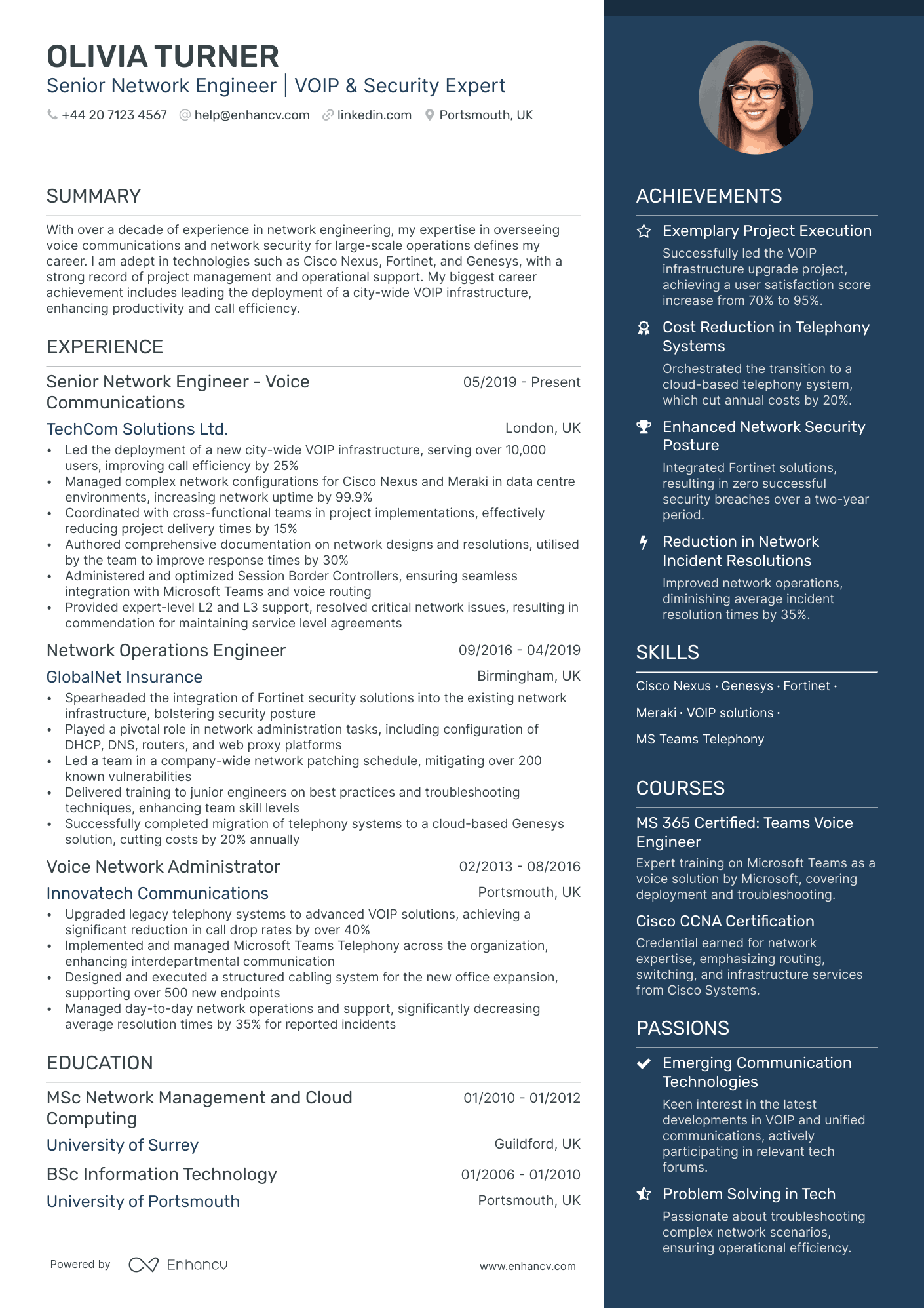
Traditional

Resume Guide
CV Format Tips
Summary or Objective?
Experience on Your CV
No Experience?
Top CV Skills
Education & Certifications
Key Takeaways
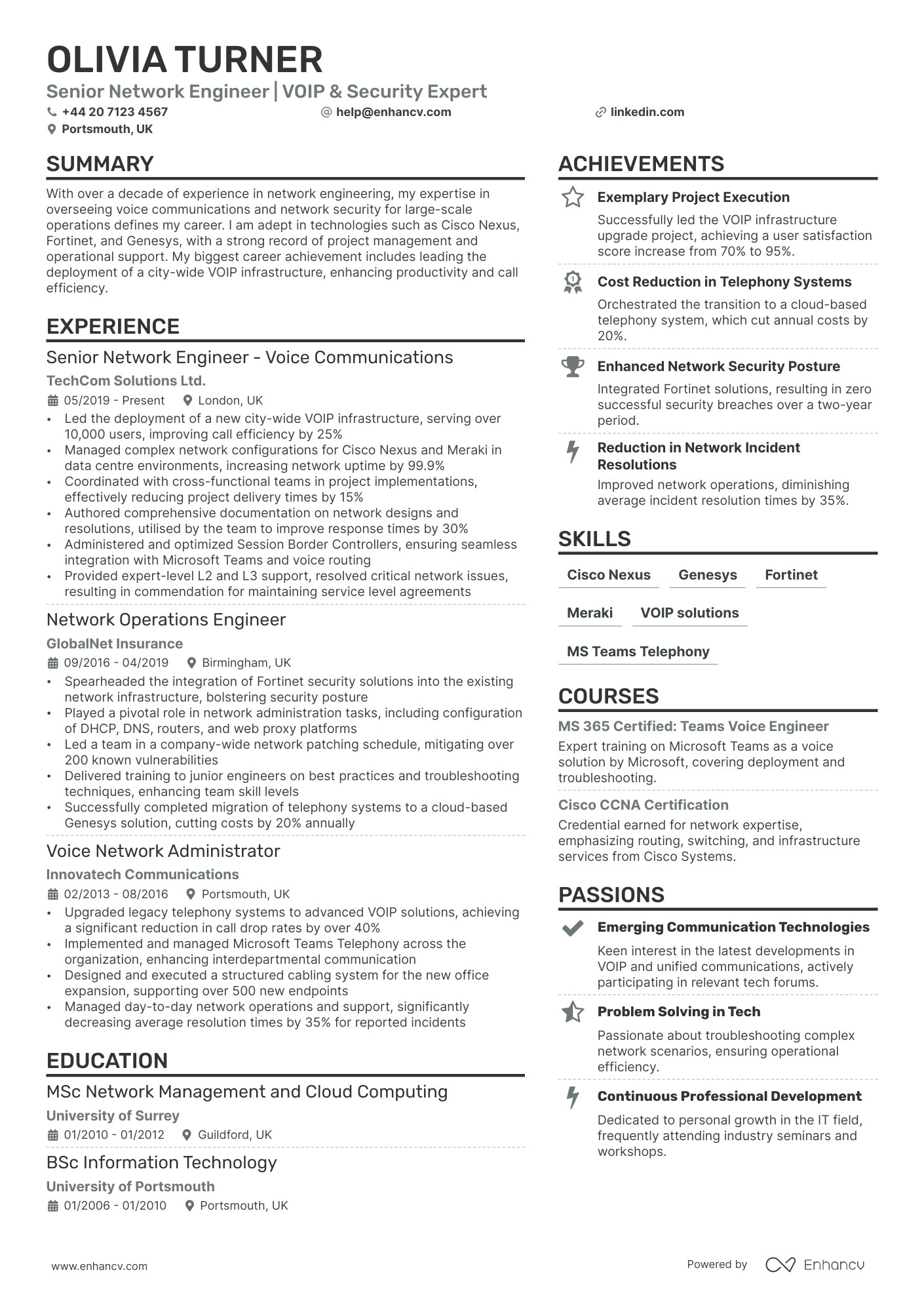
Achieving the right balance between technical jargon and accessibility on your CV can be a significant challenge in your quest to showcase your expertise as a network engineer. Our guide offers you tailored advice to fine-tune your language, ensuring it strikes the perfect note with recruiters and highlights your proficiency.
- Answer job requirements with your network engineer CV and experience;
- Curate your academic background and certificates, following industry-leading CV examples;
- Select from +10 niche skills to match the ideal candidate profile
- Write a more succinct experience section that consists of all the right details.
Do you need more specific insights into writing your network engineer CV? Our guides focus on unique insights for each individual role:
- Salesforce Admin CV Example
- Penetration Tester CV Example
- Technical Writer CV Example
- Full Stack Developer CV Example
- Developer CV Example
- Computer Science CV Example
- Data Scientist CV Example
- Test Manager CV Example
- Junior Software Developer CV Example
- Service Desk Analyst CV Example
Structuring your network engineer CV layout: four factors to keep in mind
- Follows the reverse chronological order in the experience section by first listing your most recent jobs;
- Incorporates your contact information in the header, but do skip out on the CV photo for roles in the UK;
- Is spotlighted in the most important sections of your CV, e.g. the summary or objective, experience, education, etc. to show just how you meet the job requirements;
- Is no longer than two-pages. Often, the one-page format can be optimal for your network engineer CV.
Before submitting your CV, you may wonder whether to export it in Doc or PDF. With the PDF format, your information and layout stay intact. This is quite useful when your CV is assessed by the Applicant Tracker System (or the ATS) . The ATS is a software that scans your profile for all relevant information and can easily understand latest study on the ATS , which looks at your CV columns, design, and so much more.
For certain fields, consider including infographics or visual elements to represent skills or achievements, but ensure they are simple, professional, and enhance rather than clutter the information.
The top sections on a network engineer CV
- Professional Summary highlights expertise and experience.
- Technical Skills section showcases network technologies knowledge.
- Work Experience details relevant job history and achievements.
- Certifications prove formal qualifications and technical competency.
- Education Background includes degrees relevant to network engineering.
What recruiters value on your CV:
- Highlight your understanding of network infrastructure by detailing your experience with routers, switches, firewalls, and load balancers, focusing on both the design and troubleshooting aspects.
- Showcase certifications like CCNA, CCNP, or CompTIA Network+ to establish credibility and demonstrate your commitment to the professional standards in network engineering.
- Emphasise your hands-on experience with network protocols such as TCP/IP, BGP, OSPF, and EIGRP, and explain how you've applied these protocols in complex network topologies.
- Outline your proficiency in network automation by mentioning the use of scripting languages such as Python and configuration management tools like Ansible, which are becoming increasingly crucial in modern network operations.
- Document any experience with cloud services such as AWS, Azure, or Google Cloud, focusing on projects related to network connectivity, security, and performance within cloud environments.
Recommended reads:
- CV Structure: Most Common Formats and Attention-Keeping Sections
- How to Write a CV Heading: Templates, Examples & Guide
How to present your contact details and job keywords in your network engineer CV header
Located at the top of your network engineer CV, the header presents recruiters with your key personal information, headline, and professional photo. When creating your CV header, include your:
- Contact details - avoid listing your work email or telephone number and, also, email addresses that sound unprofessional (e.g. [email protected] is definitely a big no);
- Headline - it should be relevant, concise, and specific to the role you're applying for , integrating keywords and action verbs;
- Photo - instead of including a photograph from your family reunion, select one that shows you in a more professional light . It's also good to note that in some countries (e.g. the UK and US), it's best to avoid photos on your CV as they may serve as bias.
What do other industry professionals include in their CV header? Make sure to check out the next bit of your guide to see real-life examples:
Examples of good CV headlines for network engineer:
- Network Engineer | CCNP Certified | Cybersecurity Enthusiast | 5 Years in IT Infrastructure Management
- Senior Network Architect | MPLS Expert | ITIL Foundation | 10+ Years' Progressive Experience
- Junior Network Administrator | LAN/WAN Specialist | Recent CompTIA Network+ Graduate | Passion for Cloud Solutions
- Lead Network Operations Analyst | Cisco Environments | Focus on Scalability | 15 Years in Industry
- Network Solutions Engineer | Virtualisation Pro | CCIE Security | Innovative Connectivity Strategist | 8 Years
- Systems & Network Engineer | Disaster Recovery Planning | AWS Certified | Proven Track Record | 6 Years Experience
Opting between a network engineer CV summary or objective
Within the top one third of your network engineer CV, you have the opportunity to briefly summarise your best achievements or present your professional goals and dreams. Those two functions are met by either the CV summary or the objective.
- The summary is three-to-five sentences long and should narrate your best successes, while answering key requirements for the role . Select up to three skills which you can feature in your summary. Always aim to present what the actual outcomes were of using your particular skill set. The summary is an excellent choice for more experienced professionals.
- The objective is more focused on showcasing your unique value as a candidate and defining your dreams and ambitions . Think about highlighting how this current opportunity would answer your career vision. Also, about how you could help your potential employers grow. The objective matches the needs of less experienced candidates, who need to prove their skill set and, in particular, their soft skills.
Still not sure about how to write your CV opening statement ? Use some best industry examples as inspiration:
CV summaries for a network engineer job:
- Accomplished Network Engineer with over 10 years of experience in designing, implementing, and troubleshooting complex networks for large organisations. Expertise in Cisco routers, switches, and firewalls. Successfully reduced network outages by 30% for a Fortune 500 company through strategic enhancements.
- Dedicated IT Professional transitioning into Network Engineering with a strong foundation in software development and system administration, bringing 5 years of tech experience. Proficient in Python and Linux environments, with a commitment to achieving CCNA certification to further enhance network management skills.
- Dynamic Systems Analyst, pivoting to a Network Engineer career, leveraging 6 years of experience with enterprise data systems, SQL database management, and a recent focus on network security protocols. Actively seeking to apply analytical skills to a more focused technical networking role.
- Senior Network Engineer, with 15+ years steering complex network projects, holding multiple Cisco certifications, and proficient in multivendor environments. Recognised for designing a secure and resilient network infrastructure for a leading e-commerce platform that supported a 200% traffic surge.
- Aspiring Network Engineer, eager to build foundational expertise in network design, analysis, and security. Keen to apply academic skills from a Master's in Computer Science and recent CCENT certification to real-world applications and contribute to the development of cutting-edge network solutions.
- Recent graduate in Network Systems with a passion for cybersecurity seeking to apply theoretical knowledge and hands-on experience gained through university labs and a 6-month internship. Aim to develop skills in network automation and management with a focus on protecting digital assets against emerging threats.
Narrating the details of your network engineer CV experience section
Perhaps you've heard it time and time again, but, how you present your experience is what matters the most. Your CV experience section - that details your work history alongside your accomplishments - is the space to spotlight your unqiue expertise and talents . So, avoid solely listing your responsibilities, but instead:
- adverts' keywords and integrate those in your experience section;
- Use your CV to detail how you've been promoted in the past by including experience in the reverse chronological order.
Before you start writing your network engineer CV experience section, dive into some industry-leading examples on how to structure your bullets.
Best practices for your CV's work experience section
- Designed and implemented secure network infrastructures using Cisco, Juniper, and HP equipment to support organisational needs, minimising downtime and maximising performance.
- Configured and maintained network hardware including routers, switches, and firewalls, ensuring robust security and compliance with industry standards.
- Utilised network monitoring tools such as SolarWinds, Nagios, and Wireshark to proactively identify and resolve network issues, reducing the mean time to repair by 30%.
- Developed network documentation and topology maps to provide clear understanding of network designs for cross-functional teams and management.
- Led troubleshooting and problem-solving efforts during network outages, coordinating with vendors and IT teams to restore services swiftly.
- Coordinated with project managers on new site deployments, successfully rolling out network infrastructure in line with project timelines and company standards.
- Implemented network security measures, including VPNs, access control lists (ACLs), and intrusion detection systems (IDS) to safeguard sensitive data.
- Planned and executed network upgrades and migrations without service interruption, using change management protocols to maintain operational stability.
- Collaborated with cyber security teams to conduct network audits and vulnerability assessments, recommending enhancements to fortify network defences.
- Designed and implemented a secure multi-site LAN/WAN environment for a leading financial firm, ensuring high availability and redundancy.
- Successfully led the migration of data centre infrastructure to a hybrid cloud model, cutting operational costs by 20%.
- Coordinated with cross-functional teams to roll out VoIP solutions across 10+ locations, enhancing communication capabilities company-wide.
- Spearheaded the deployment of a Cisco-based network infrastructure, resulting in a 30% increase in network performance.
- Developed comprehensive network security policies, and conducted training for 100+ staff members on cybersecurity best practices.
- Optimised network configurations that allowed for a seamless introduction of BYOD policies, increasing employee satisfaction and productivity.
- Managed a team responsible for the maintenance and troubleshooting of a complex WAN infrastructure connecting over 50 international branches.
- Architected a scalable network design using MPLS technology that improved data transfer efficiency between branches by 40%.
- Conducted network performance analyses periodically and proposed enhancements, which reduced downtimes by 15% annually.
- Executed the rollout of an enterprise-grade firewall and intrusion detection system, bolstering the network's resilience to cyber-attacks.
- Led a successful pilot program integrating IoT devices into the existing network, enhancing operational efficiency in manufacturing processes.
- Created detailed network documentation and topology maps, significantly reducing the incident response time.
- Implemented a network monitoring solution that provided real-time insights into network traffic, reducing unidentified traffic by 25%.
- Championed the upgrade of network infrastructure to support 10Gbps connectivity across the organization, facilitating high-speed data access.
- Developed disaster recovery plans that ensured 99.99% uptime, preserving business continuity during critical periods.
- Orchestrated the end-to-end network lifecycle management for over 200 switches and routers, ensuring optimal network performance.
- Implemented a new routing protocol strategy using OSPF, which resulted in a 35% improvement in network convergence times.
- Collaborated with external vendors to secure networking equipment at competitive prices, saving the company an average of 10% on annual procurement costs.
- Drove the design and deployment of a WAN optimization project that increased application performance by over 50% for remote users.
- Led a cross-functional team in a large-scale SD-WAN implementation, enhancing network agility and reducing reliance on traditional MPLS connections.
- Evaluated and integrated network management tools that provided comprehensive visibility into network health and performance metrics.
- Instrumental in designing a network traffic load balancing system that evenly distributed service demands, dramatically reducing instances of bottlenecks.
- Managed critical network upgrade projects in tight timeframes, which included successfully replacing legacy switches without disrupting business operations.
- Routinely collaborated with the cybersecurity team to ensure that network architecture aligned with stringent industry security standards.
How to ensure your network engineer CV stands out when you have no experience
This part of our step-by-step guide will help you substitute your experience section by helping you spotlight your skill set. First off, your ability to land your first job will depend on the time you take to assess precisely how you match the job requirements. Whether that's via your relevant education and courses, skill set, or any potential extracurricular activities. Next:
- Systematise your CV so that it spotlights your most relevant experience (whether that's your education or volunteer work) towards the top;
- Focus recruiters' attention to your transferrable skill set and in particular how your personality would be the perfect fit for the role;
- Consider how your current background has helped you build your technological understanding - whether you've created projects in your free time or as part of your uni degree;
- Ensure you've expanded on your teamwork capabilities with any relevant internships, part-time roles , or projects you've participated in the past.
- How to Address Employment Gaps on Your CV (With Templates for 2025)
- How to List Qualifications on Your CV (Tips & Examples for 2025)
Include examples of how you adapted to new tools, environments, or work cultures, showing your flexibility.
Key network engineer CV skills: what are hard skills and soft skills
Let's kick off with the basics. You know that you have to include key job requirements or skills across your CV. For starters, take individual skills from the job description and copy-paste them into your CV, when relevant. Doing so, you'll ensure you have the correct skill spelling and also pass the Applicant Tracker System (ATS) assessment. There are two types of skills you'll need to include on your CV:
- Hard skills - technical abilities that are best defined by your certificates, education, and experience. You could also use the dedicated skills section to list between ten and twelve technologies you're apt at using that match the job requirements.
- Soft skills - your personal traits and interpersonal communication skills that are a bit harder to quantify. Use various CV sections, e.g. summary, strengths, experience, to shine a spotlight on your workspace achievements, thanks to using particular soft skills.
Remember that your job-winning CV should balance both your hard and soft skills to prove your technical background, while spotlighting your personality.
Top skills for your network engineer CV:
Network Design and Implementation
Routing Protocols (BGP, OSPF, EIGRP)
Switching (VLAN, STP)
Network Security (Firewalls, IDS/IPS)
WAN Technologies (MPLS, VPLS, VPN)
IP Addressing and Subnetting
Network Troubleshooting and Diagnostics
Wireless Networking Standards
Network Management Tools (SolarWinds, Nagios)
Cloud Networking (AWS, Azure Networking Services)
Analytical Thinking
Problem-Solving
Communication
Adaptability
Continuous Learning
Time Management
Attention to Detail
Project Management
Customer Service
Use mini case studies or success stories in your CV to demonstrate how your skills have positively impacted previous roles or projects.
Education and more professional qualifications to include in your network engineer CV
If you want to showcase to recruiters that you're further qualified for the role , ensure you've included your relevant university diplomas. Within your education section :
- Describe your degree with your university name(-s) and start-graduation dates;
- List any awards you've received, if you deem they would be impressive or are relevant to the industry;
- Include your projects and publications, if you need to further showcase how you've used your technical know-how;
- Avoid listing your A-level marks, as your potential employers care to learn more about your university background.
Apart from your higher education, ensure that you've curated your relevant certificates or courses by listing the:
- name of the certificate or course;
- name of the institution within which you received your training;
- the date(-s) when you obtained your accreditation.
In the next section, discover some of the most relevant certificates for your network engineer CV:
If there's a noticeable gap in your skillset for the role you're applying for, mention any steps you're taking to acquire these skills, such as online courses or self-study.
- How to Include CV Coursework on Your CV
- How to Showcase Your Educational Achievements on CV: Examples, Templates, & Guide for 2025
Key takeaways
Your successful job application depends on how you well you have aligned your network engineer CV to the job description and portrayed your best skills and traits. Make sure to:
- Select your CV format, so that it ensures your experience is easy to read and understand;
- Include your professional contact details and a link to your portfolio, so that recruiters can easily get in touch with you and preview your work;
- Write a CV summary if you happen to have more relevant professional experience. Meanwhile, use the objective to showcase your career dreams and ambitions;
- In your CV experience section bullets, back up your individual skills and responsibilities with tangible achievements;
- Have a healthy balance between hard and soft skills to answer the job requirements and hint at your unique professional value.

Looking to build your own Network Engineer CV?

- CV Examples
Frequently asked questions about Network Engineer CVs
Q: how do i show my teamwork skills on my network engineer cv, q: what should a fresher include in a network engineer cv, q: how do i justify the gaps in my network engineer cv.

300+ Keywords for Your CV in 2025: Examples & How-To Guide

Military To Civilian CV - Templates & Examples to Use in 2025

How To Craft a Stellar CV Objective: 9 Examples & Tips for 2025
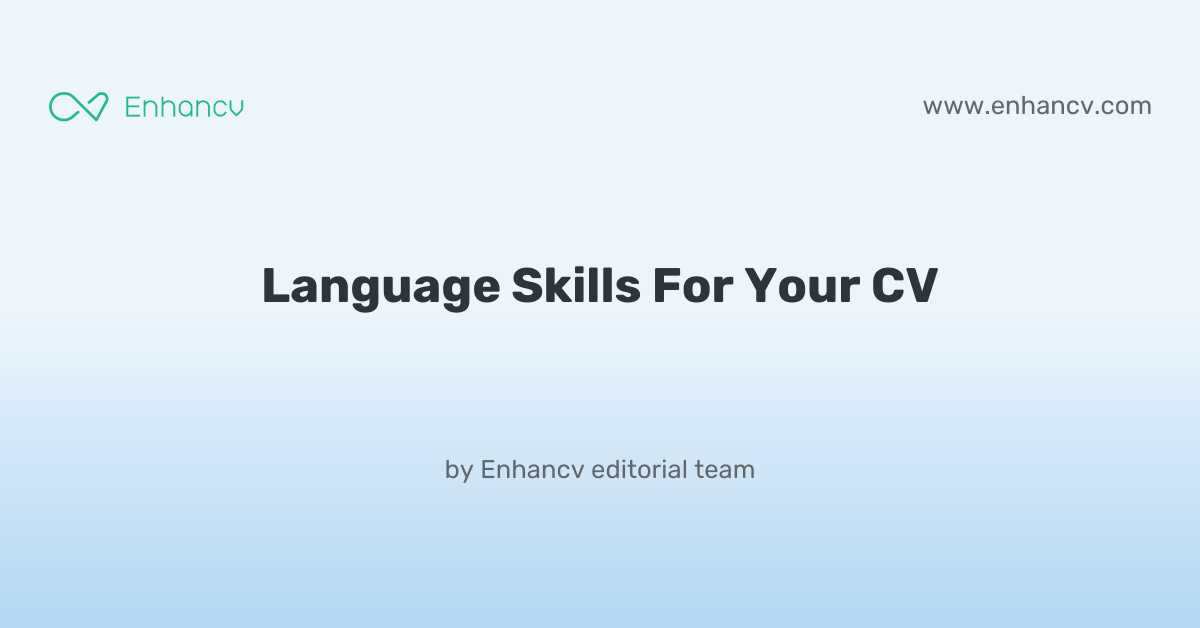
Why Your CV Language Skills Matter: 2025 Best Practices to Get Hired
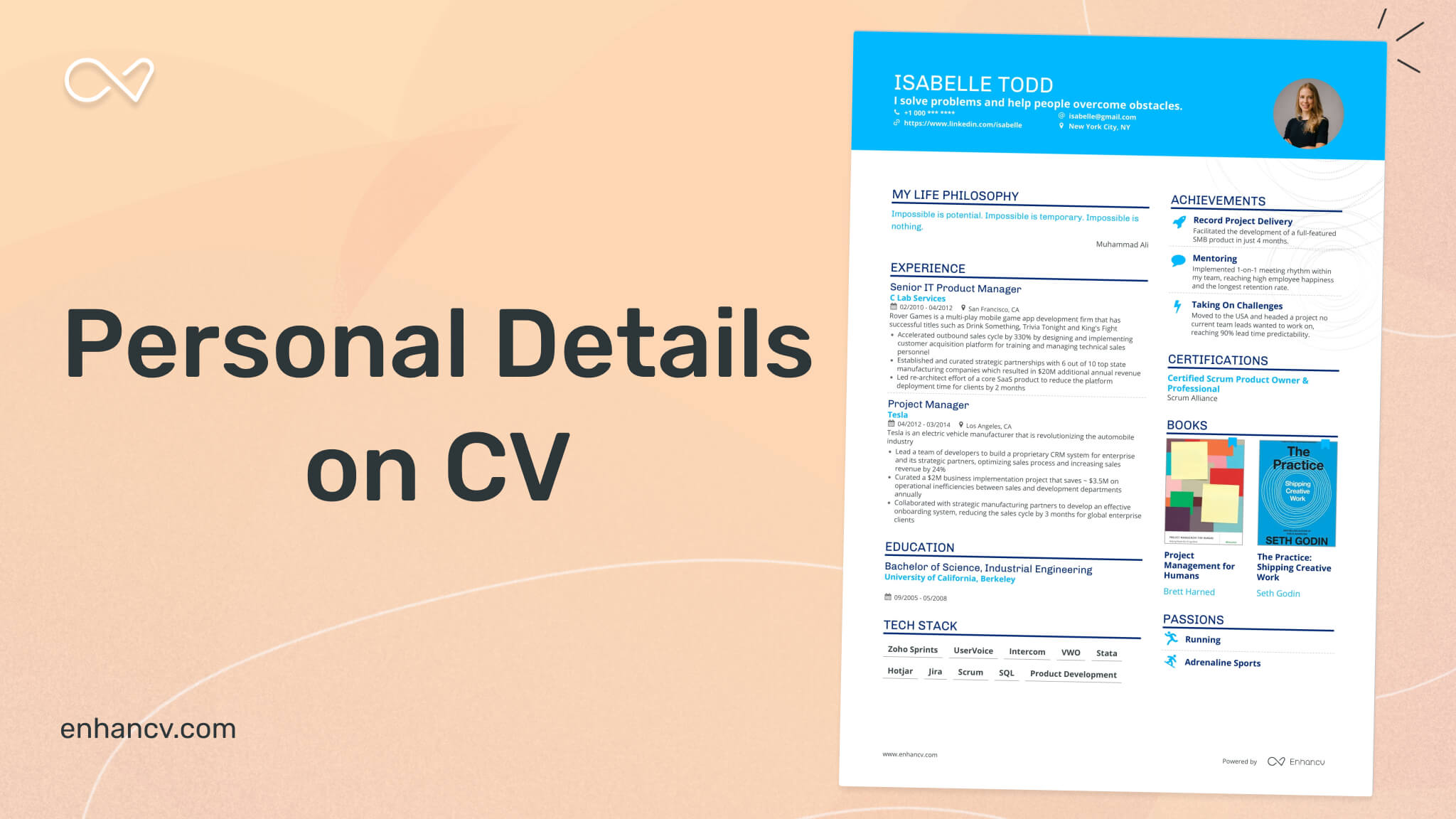
Personal Details on CV (Contact Info, Phone Number & More)

CV Achievement Examples to Land Your Dream Job (Guide + Template)
- Terms of Service
- Privacy Policy
- Cookie Preferences
- CV Templates
- AI CV Builder
- How to Write a CV
- [email protected]
- English (US)
- French (FR)
- German (DE)
- Spanish (ES)
- Swedish (SE)
Made with love by people who care.
© 2024 . All rights reserved.

IMAGES
VIDEO
COMMENTS
The personal statement in your Network Engineer CV is a golden opportunity to make a lasting impression. It's a platform to highlight your unique technical skills, your passion for network solutions, and your career aspirations. It should succinctly spotlight your career goals, key skills, and the unique value you can bring to potential ...
A strong personal statement for a Network Engineer CV seamlessly blends professional achievements with specific networking skills, clearly demonstrating the candidate's value through measurable outcomes. It stands out by being highly tailored to the networking field, highlighting expertise in areas like network architecture, cybersecurity, and ...
Write a network engineer personal statement that connects with your recruiter. ... This section should be 2-3 lines long and is also known as a personal summary. In your network engineer personal statement, you need to show why you're the best candidate for the role. Outline your current employment, career goals, and key attributes, including ...
Grab the reader's attention by kick-starting your CV with a powerful profile (or personal statement, if you're a junior applicant). This is a short introduction paragraph which summarises your skills, knowledge and experience. ... "As a Network Engineer for The Computer Agency, I ensure the high performance of network infrastructure ...
Fresher Network Engineer Personal Statement Examples. ... A strong personal statement for a Fresher Network Engineer CV effectively combines technical skills with problem-solving abilities, clearly demonstrating the candidate's value through their knowledge and passion for the field. It stands out by being highly tailored to the network ...
Enhance your network engineer resume with our useful guide. It includes 15 great examples, pro tips, and a free resume checker tool. Boost your tech career now! ... Personal statements are vital, especially if you have a diverse educational background or a wide range of experiences. They help clarify how your skills and experiences make you a ...
A network engineer CV needs to demonstrate technical expertise, project experience, and a proactive approach to managing network systems. Here's a guide on how to structure your CV with the provided sections: 1. Write a strong personal statement. Your personal statement should summarise your technical skills and relevant qualifications in 3 ...
Example of personal statement for Cisco network engineer CV. A self-motivated Cisco network engineer with over 10 years of progressive experience in Network Protocols, Communication Networks, and Firewalls. Comprehensive Cisco technology knowledge in designing, implementation, administration, and support. ...
When you put those two tips together, a bullet point on your network engineer resume might read, "Maintained AWS Direct Connect and VPC to improve bandwidth and reduce network costs for clients by 17% on average." Lastly, a good network engineer resume will always be complemented by a terrific cover letter.
Located at the top of your network engineer CV, the header presents recruiters with your key personal information, headline, and professional photo. When creating your CV header, include your: Contact details - avoid listing your work email or telephone number and, also, email addresses that sound unprofessional (e.g. [email protected] ...